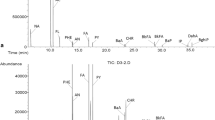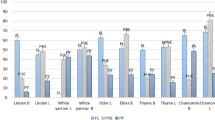Abstract
For the analysis of the 16 PAH (EFSA-PAH), which are classified as priority for different food groups by the Scientific Committee on Food (SCF) and the Joint FAO/WHO Experts Committee on Food Additives (JECFA) in tea, a sensitive analytical Fast-GC/HRMS method was used. The sample preparation included accelerated solvent extraction (ASE) and the highly automated clean up steps, gel permeation chromatography and solid phase extraction. The analytical parameters, limit of detection (0.01–0.02 μg/kg) and limit of quantification (0.03–0.06 μg/kg), were determined. The repeatability (RSD, n = 3) of different PAH in fruit tea ranged from 0.1 to 11%. It was observed that the total contents of the 16 PAH in tea samples ranged from 14 to 2,662 μg/kg. The analysed tea samples showed an increasing presence of PAH in the following order: herbal and fruit tea (n = 7) < black tea (n = 11) < green tea (n = 11) < white tea (n = 3) < mate-tea (n = 8). The correlation coefficient (R) between BaP and the sum of the 16 EFSA-PAH was established considering the contamination amount in all the 40 tea samples analysed.


Similar content being viewed by others
Abbreviations
- 5MC:
-
5-Methylchrysene
- ASE:
-
Accelerated solvent extraction
- BaA:
-
Benzo[a]anthracene
- BaP:
-
Benzo[a]pyrene
- BbF:
-
Benzo[b]fluoranthene
- BcL:
-
Benzo[c]fluorene
- BgP:
-
Benzo[g,h,i]perylene
- BjF:
-
Benzo[j]fluoranthene
- BkF:
-
Benzo[k]fluoranthene
- CPP:
-
Cyclopenta[c,d]pyrene
- CHR:
-
Chrysene
- D/A:
-
Dichloromethane/acetone
- DeP:
-
Dibenzo[a,e]pyrene
- DhA:
-
Dibenzo[a,h]anthracene
- DhP:
-
Dibenzo[a,h]pyrene
- DiP:
-
Dibenzo[a,i]pyrene
- DlP:
-
Dibenzo[a,l]pyrene
- EFSA:
-
European Food Safety Authority
- EPA:
-
Environmental Protection Agency
- GPC:
-
Gel permeation chromatography
- HRMS:
-
High resolution mass spectrometer
- IcP:
-
Indeno[1,2,3-cd]pyrene
- IQR:
-
Interquartile range
- JECFA:
-
Joint FAO/WHO Experts Committee on Food Additives
- KOH:
-
Potassium hydroxide
- LLE:
-
Liquid liquid extraction
- LOD:
-
Limit of detection
- LOQ:
-
Limit of quantification
- Na2SO4 :
-
Sodium sulphate
- PAH:
-
Polycyclic aromatic hydrocarbons
- SCF:
-
Scientific Committee on Food
- SIM:
-
Selected ion monitoring
- SPE:
-
Solid phase extraction
References
Simonich SL, Hites RA (1994) Environ Sci Technol 28:939–943
Lin DH, Zhu LZ (2004) J Agric Food Chem 52:8268–8271
Lin DH, Zhu LZ, Luo L (2006) J Agric Food Chem 54:4350–4354
Gao YZ, Zhu LZ (2004) Chemosphere 55:1169–1178
Lin DH, Zhu LZ, He W, Tu YT (2006) J Agric Food Chem 54:3658–3662
Speer K (1987) Deutsche Lebensmittel-Rundschau 83:80–83
Fiedler H, Cheung CK, Wong MH (2002) Chemosphere 46:1429–1433
Schlemitz S, Pfannhauser W (1997) Z Lebensm Unters Forsch A 205:305–310
Ciemniak A (2005) Rocz Panstw Zakl Hig 56:317–322
Lin DH, Tu YY, Zhu LZ (2005) Food Chem Toxicol 43:41–48
Kayali-Sayadi MN, Rubio-Barroso S, Cuesta-Jimenez MP, Palo-Diez LM (1998) Analyst 123:2145–2148
Camargo MCR, Toledo MCF (2002) Ciencia e Tecnologia de Alimentos 22:49–53
Zuin WG, Montero L, Bauer C, Popp P (2005) J Chromatogr A 1091:2–10
Bishnoi NR, Mehta U, Sain U, Pandit GG (2005) Environ Monit Assess 107:399–406
Ciemniak A (2004) Bromatologia i Chemia Toksykologiczna 37:25–29
Commission Regulation (EC) No 208/2005 of 4 February 2005 amending Regulation (EC) No 466/2001 as regards polycyclic aromatic hydrocarbons. Off J Eur Union L 34:3–5
Commission Regulation (EC) No 1881/2006 of 19 December 2006 setting maximum levels for certain contaminants in foodstuffs. Off J Eur Union L 364:5–24
Commission Recommendation of 4 February 2005 on the further investigation into the levels of polycyclic aromatic hydrocarbons in certain foods. Off J Eur Union L 34:43–45
McClure P, Scheny R (1995) In: 15th international symposium on polycyclic aromatic compounds, Belgirate, Italy, 19–22 Sept 1995, p 161
Müller P, Leece B, Raha D (1995) In: 15th international symposium on polycyclic aromatic compounds, Belgirate, Italy, 19–22 Sept 1995, pp 159–160
Summary and Conclusion of the Joint FAO/WHO Expert Committee on Food Additives, 64th meeting, Rome, 8–17 February 2005, JECFA/64/SC
Simon R, Palme S, Anklam E, Declaire L et al (2006) J AOAC Int 89:772–781
Simon R, Palme S, Anklam E (2006) J Chromatogr A 1103:307–313
IRMM, Institute for Reference Materials and Measurements (2006) Interlaboratory comparison: PAHs in edible oils. http://www.irmm.jrc.be/html/interlaboratory_comparisons/index.htm
Ziegenhals K, Hübschmann HJ, Speer K, Jira W (2008) J Sep Sci 31:1779–1786
Jira W, Ziegenhals K, Speer K (2008) Food Addit Contam 25:704–713
Ruschenburg U, Jahr D (1986) Cafe Cacao The 30:3–6
Shatta AA (1999) Adv Food Sci 21:170–176
Eskinja M, Eskinja I, Soljic Z, Schmid ER (1995) Ernaehrung 19:600–602
Fontcuberta M, Arques JF, Martinez M, Suarez A et al (2006) J Food Protect 69:2024–2028
Stijve T, Hischenhuber C (1987) Deutsche Lebensmittel-Rundschau 83:276–282
Kleinhenz S, Jira W, Schwind KH (2006) Mol Nutr Food Res 50:362–367
Wenzl T, Simon R, Kleiner J, Anklam E (2006) Trends Analyt Chem 25:716–725
Author information
Authors and Affiliations
Corresponding author
Rights and permissions
About this article
Cite this article
Ziegenhals, K., Jira, W. & Speer, K. Polycyclic aromatic hydrocarbons (PAH) in various types of tea. Eur Food Res Technol 228, 83–91 (2008). https://doi.org/10.1007/s00217-008-0909-8
Received:
Revised:
Accepted:
Published:
Issue Date:
DOI: https://doi.org/10.1007/s00217-008-0909-8




